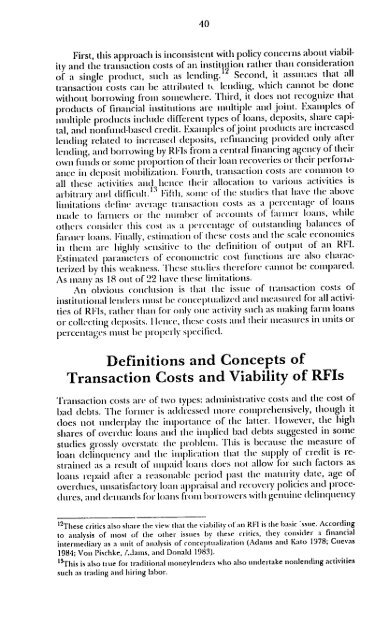I Fiance Apicultural
I Fiance Apicultural
I Fiance Apicultural
You also want an ePaper? Increase the reach of your titles
YUMPU automatically turns print PDFs into web optimized ePapers that Google loves.
40<br />
First, this approach is inconsisteit with policy concerns about viability<br />
aild the transaction costs of an institlition rather than consideration<br />
of a single product, stuch as lending. 12 Second, it asstliles that all<br />
transaction costs call be attriluted 1t.lending, which cannot be done<br />
without borrowing firoin soiiiewhere. Third, it does not recognize that<br />
produicts of financial institutions are multiple and joint. Examples of<br />
multiple prodttcs inclhde different types of loans, deposits, share capital,<br />
and tonfuind-based credit. Examiples ofjoint prodtcts are increased<br />
lending related to increased deposits, refinancing provided only after<br />
lending, and borrowing by RFIs from a central financing agency of their<br />
own fulds or soie proportion of their loan recoveries or their performalice<br />
in deposit mobilization. Fourth, transaction costs are collillioll to<br />
all these activities and hence tlhir allocatioi to various activities is<br />
ari)itiary and difficlilt. 13 Fifth, sonic of the studies that have the above<br />
liiiitatiolis defilit avi;tge transactioni costs as a percentage of loals<br />
iiade to fiimiers or the ,iliiler of iiccotiits of fiu-uer loaits, while<br />
others consider this cost as a 1 ercelitage of oulsalildiig balances of'<br />
fariier loans. Finally, estimiation of ilitse costs and the scale economies<br />
illtihen are highly sensitive to the defiuition of output of illRFI.<br />
E.stiiated palan tTers of' econtlOiet ric cost fnlictions are also cliarac<br />
terized by this weakness. These sttidies therefore cainot be compared.<br />
As many as 18 out of 22 have these limitations.<br />
An obvious conclusion is lhat the issue of transaction costs of<br />
institltional Ileu heis iiist Ibe co itice tI) ii aize I and measured for all activi<br />
ties of RFIs, rather tliai for oily oiliactivity such as making farm loans<br />
or colk'cting deposits. I lence, these costs and their ,ieasutes in idts or<br />
percentages uitist )e pro)ely specified.<br />
Definitions and Concepts of<br />
Transaction Costs and Viability of RFIs<br />
Trtansaction costs are of' two types: administrative costs and the cost of<br />
bad debts. The former is addressed more coiiiprelietmsively, though it<br />
does not tunderplay tile itportanice of tile latter. I loweve,, the high<br />
shares of overduet loans and the implied bad debts suggested in some<br />
studies grossly overstatc tIle prol)lem. This is because tile measure of<br />
loan deliuqueicy and the implication that the supply of credit is re<br />
straited as a i-eslilt of unpaid loaiis (toes not allow for such factors as<br />
loans repaid after a reasonalble period past the maturity date, age of<br />
overduies, tnsatisfactomy loau appraisal and recovery policies and proce<br />
(ires, and demauds for loans fron borrowers with genuine delinquency<br />
1 2 Thesc citics also share the view that tie viability 0 an RFI is the basic ,ssuc. According<br />
to analysis of most of the other issues by ihese critics, they consider .tfinancial<br />
intermediary as a unit of analysis of conceptualization (Adams and Kato 1978; Cuevas<br />
19841; Von Pischke,.Adams, and Donald 1983).<br />
"Thtisis also trte fo, traditional moneylenders who also undertake nonlending activities<br />
such as trading and hiring Labor.

















